Best Long Range Rifles of 2024
We may earn revenue from the products available on this page and participate in affiliate programs. Learn More ›
So, you’re fixing to get your first long-range rifle? As John McClane said, “Welcome to the party, pal.” Picking a long-range rifle didn’t used to be difficult but the task has become more complex these days.
Not long ago, there wasn’t much variety to choose from. Most long-range hunting rifles were typically the standard sporter weight hunting model but with a longer and heavier barrel screwed into the action. Often these rifles included an extra swivel stud on the fore-end to mount a Harris-style bipod.
Today, we have an abundance of long-range rifles for every conceivable application, whether the goal is to ring steel at a mile or hunt above the tree line in the Rockies.
I’ve shot and evaluated a lot of these rifles over the years, collecting data along the way. With help from my Outdoor Life colleagues who’ve done a fair measure of trigger pulling as well, we’ve seen a very heartening trend. Year by year, production rifles are getting more accurate.
Choosing a Long-Range Rifle
Long-range rifles come in many flavors, depending on the shooter’s needs and desires. At the far end are heavy task-specific rifles for competition and ELR (Extreme Long Range) chores. These are rifles that are built for shooting out to 2,000 yards and optimized for the Precision Rifle Series and similar games.
Then there are crossover hybrid models that can be used in certain competitions or hunting applications. These rifles also appeal to recreational shooters that like to ring steel at long distances, but don’t have a burning desire to compete.
Lastly, there are lighter guns that also happen to be stunningly accurate. They are ideal for hunting and for shooting in long-range competitions like the NRL Hunter series that impose weight limits. They also showcase some of the most innovative technologies with lightweight materials that are able to hold the tolerances that precision rifles demand.
How I Picked the Best Long-Range Rifles
I went through years of data compiled during our annual tests of the year’s best new rifles and through my reviews of individual long guns. The rifles here are the most accurate I’ve shot. They also excel in other categories as well, such as handling, ergonomics and reliability. Though these rifles aren’t cheap, many of them represent excellent values for the money.
A Note On Our Long-Range Rifle Accuracy Data
The accuracy figures here are derived from the average of the 10 best five-shot groups these rifles delivered during our evaluations. For many years this has been Outdoor Life’s accuracy standard, and is the most rigorous in the industry.
In the last year, we’ve upped the bar. We now incorporate data for 20-shot groups and mean radius in our reviews and gun tests. Since many of these rifle were shot prior to establishing this protocol, we don’t have 20-shot groups for all of them. To be consistent we’ve published the five-shot average group data here.

Photo by Scott Einsman
See It
- Average Group: .719 inch (73 groups)
- Test Gun 6.5 Creedmoor
Every now and then a truly special rifle makes an appearance, and this Browning X Bolt 2 is one such example.
Browning introduced the X Bolt 2 in 2024 with many upgrades over its successful predecessor. Included in the new X Bolt 2 family is this lightweight model that features a McMillan Game Warden 2.0 stock and 18-inch carbon fiber barrel from Preferred Barrel Blanks.
Browning tweaked the action to make the three-lug bolt run more smoothly and added a new trigger — called the DLX — that is user adjustable and that on our sample broke at a crisp 3-pounds, 2-ounces.
The stubby barrel keeps the overall length down (just 38.25 inches) and allows the rifle to pair well with a suppressor. During our evaluation we ran it with two cans in particular — the Banish Backcountry and the SilencerCo Scythe Ti.
The rifle handles extremely well, balancing nicely even with a suppressor threaded on, and had good ergonomics.
But the rifle’s accuracy is where it really shone. To date, we’ve put more than 73 five-shot groups through the rifle using 14 different types of 6.5 Creedmoor ammo. (You can also get this rifle in .308 Win., 6.5 PRC, 6.8 Western, 7mm PRC, .300 Win. Mag., and 300 PRC.)
Out of all those groups, only five measure more than one inch, with the largest being 1.128 inches. The average of all the groups was .719 inch, which is just outstanding.This X-Bolt 2 is one of the most accurate guns we’ve ever tested, an especially notable achievement for a rifle that’s under 6 pounds. You can check out Tyler Freel’s detailed review if you want to learn more.
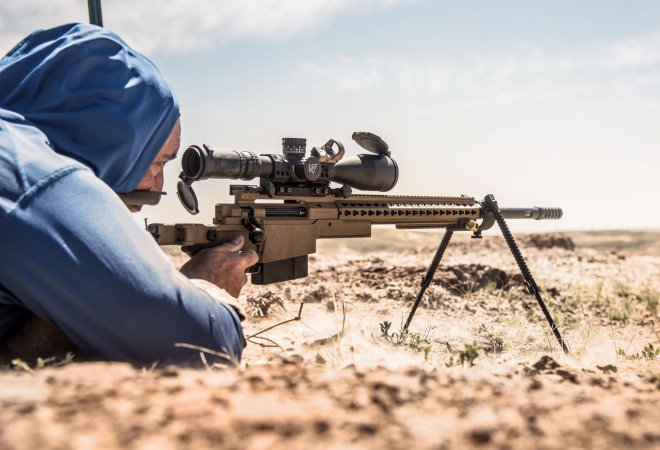
The author behind the trigger of an Accuracy International AXSR.
See It
- Average Group: Varies by caliber
- Best Group: Varies by caliber
The AI AXSR combines rugged construction, multi-caliber versatility, dead-nuts precision, and excellent ergonomics like no other rifle in the world. As I wrote in my roundup of the best sniper rifles, it is tough enough to survive a fall out of a helicopter and still be able to make shots on a 10-inch plate at a mile.
When I wrote that, I was rocking it in the potent .300 Norma Magnum, but more recently I swapped the bolt body and barrel to run handloaded .300 PRC ammo through it at the Nightforce ELR Steel challenge where I took 10th place out of nearly 190 competitors in the open heavy division.
That grueling match features two days of shooting at targets out to 2,100 yards and if you dig into who was shooting what, you’ll see that the top two teams in the match were also shooting AXSRs, as did the second-place overall finisher in the match, as well as the top military/LE shooter.
In fact, no other rifle came close to replicating the success of the AI AXSR at this match, which is the most demanding of its kind in the world.
With my handloads, running 230-grain Hornady A-Tips over 77.4 grains of H1000, my five-shot groups averaged in the .5s and .6s. Other shooters running their AXSRs in .300 PRC with that bullet reported similar results.
Even with factory ammo, such as Hornady’s 212-grain ELD-X load, my rifle shot 10-shot groups averaging .75-MOA, which is remarkable for a magnum.
This is one of the more expensive rifles out there, but if you have your heart set on the best, the juice is worth the squeeze.

See It
- Test Gun: 6.5 PRC
- Average Group: .758 inches
- Best Group: .483 inches
Gun makers looking to build the ultimate hunting rifle have worked hard to blend elements of accuracy taken from the competition world into a platform that is usable for stalking game in the mountains or when setting up for long-shots in open country. No one has succeeded as well as Glen Seekins, the man behind the Havak Pro Hunter.

He created a lightweight rifle that could survive punishing treatment and put one shot after another on target.
The stock on the Havak Pro Hunter 2 has a broad fore-end, a nearly vertical pistol grip with ample palm swells and QD cups for slings and other attachments—all of which are common on competition rifles. The deep spiral fluting on the barrel keeps the weight of the rifle down but doesn’t have any adverse impact on accuracy. My rifle in 6.5 PRC averaged .75 MOA with Hornady factory ammo shooting 5-shot groups.
The rifle runs flawlessly, looks great, and given its feature set and quality, is an amazing value.

See It
- Test Gun: .308 Winchester
- Average Group: .877 inches
- Best Group: .673 inches
The Mauser M18 won our admiration, and our Great Buy award, when it debuted in 2018. This three-lug bolt-action based on a Remington 700 pattern receiver is a screaming deal, especially in light of the excellent accuracy it demonstrated with factory ammo.
The price has crept up a bit since 2018, but you can still find them for less than $800 if you shop around. Currently, it’s the best long-range deer rifle for the money.

The rifle is basic, but solid. The action on this German-built rifle runs smoothly in the receiver, plus it has a good trigger and a three-position safety that locks the bolt down when on “safe.”
Among the hunting ammo that did very well in our M18 was Nosler’s 165-grain Accubond, which turned in a .673-inch group, and happens to be one of the world’s best big-game bullets to boot.
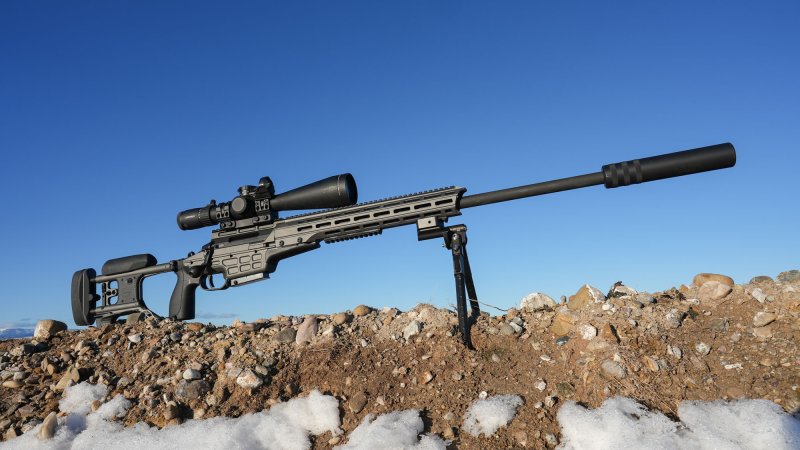
The Sako TRG 22 A1 is one of the most capable and refined precision rifles made today.
See It
- Test Gun: 6.5 CM
- Average Group: .384 inches
- Best Group: .050 inches
The Sako TRG 22 A1 is the most accurate factory rifle I’ve ever tested and is one of the world’s top sniper rifles as well. I reviewed this Finnish marvel not long ago, getting into the nitty-gritty of its construction to shed some light on why it shoots as well as it does.
First off, the Finns have a long history of not only making accurate rifles but making rifles with excellent ergonomics and go-to-hell-and-back durability. They’ve been at this game a long time and when you combine their cultural roots as outdoorsmen (the Finns were among the last people on earth to transition away from a hunter-gatherer lifestyle) with their need to fend off large aggressive neighbors (I’m looking at you Russia) it is no surprise they take their rifle building seriously.

There’s a bit of sorcery with Sako’s ability to make cold hammer-forged barrels that deliver mind-boggling accuracy. No other rifle maker is their equal with this technique. And their product designers and engineers have a deep understanding of the need for a rifle to correctly fit the shooter for peak performance.
You get a feel for this with any Sako or Tikka hunting rifle, but it really comes to fruition in the TRG series—the 22, 42, and M10.
In the A1 trim, the TRG 22 employs a chassis stock that borrows heavily from the Sako M10. It has elegant and easy-to-use controls to adjust the stock to the shooter’s specific needs. The trigger adjusts for pull weight, reach and the orientation of the shoe.
The action and magazine pair beautifully for flawless cycling under any condition, and when the shooter trips the trigger, they can be confident that the bullet will strike where intended.
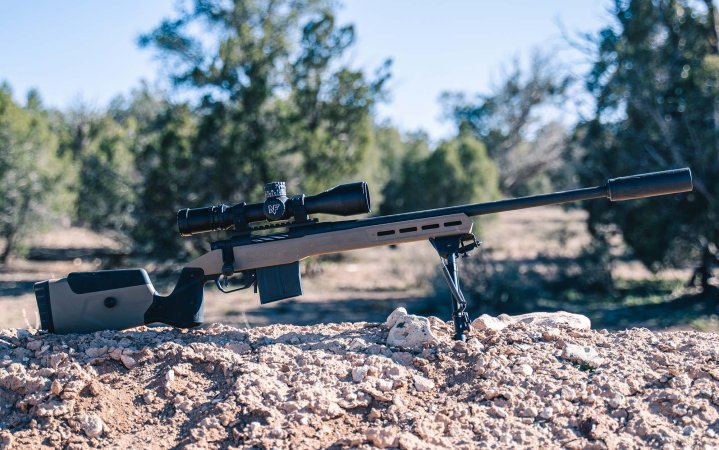
See It
- Test Gun: 6.5 CM
- Average group: .558 inches
- Best Group: .247 inches
The Mossberg Patriot LR Tactical takes the company’s workhorse Patriot action and combines it with a smartly designed stock to create one of the most affordable deals for long-range shooters.
The rifle isn’t elegant, but it handles surprisingly well. Though it comes with a heavier-contour barrel, it isn’t cumbersome. It weighs 8.75 pounds without scope and is easy to maneuver in and out of the typical types of positions one encounters in long-range field steel matches.
Of course, one reason the rifle won a Great Buy award this year is that it is very accurate.

In fact, it turned in the tightest group of this year’s rifle test, a .247-inch 5-shot group with Federal 140-grain Berger Hybrids. Overall, its 5-shot groups averaged .558 inches.
The rifle takes AICS pattern magazines, which are widely available and come in varying capacities. The effective paddle magazine release made reloads a snap. Ours was chambered in 6.5 Creedmoor, but you can also get them in 6.5 PRC and .308 Win.
The stock adjusts for cheek height and has a vertical grip that positions the trigger hand nicely. The texturing on the grip is sharp and gives a solid purchase. The chassis stock also has slots to mount M-Lok compatible accessories.
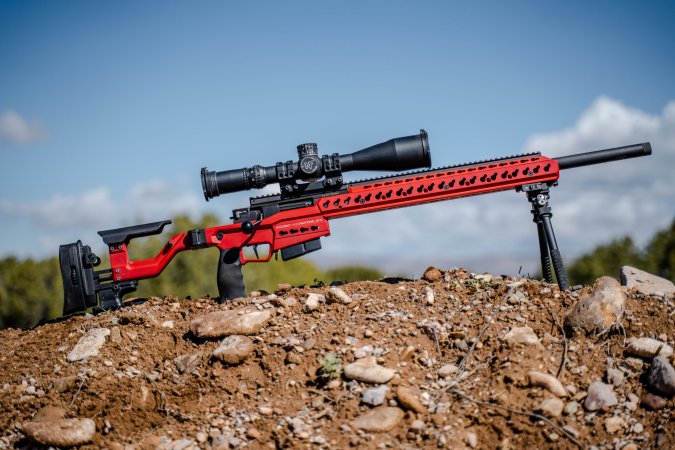
See It
- Test Gun: 6.5 CM
- Average Group: .456 inches
- Best Group: .346 inches
The original audience for Accuracy International’s rifles was military and law enforcement professionals who needed world-class precision in a rifle that could perform under extreme adverse conditions.
Plenty of civilian shooters took to AI rifles too, but the company didn’t design their products with them in mind.
While the AT-X draws heavily on AI’s history of catering to snipers, it is also configured for competition shooters, who have been running it with great success in a variety of long-range matches.
The fore-end has a flat bottom that incorporates an ARCA dovetail that extends straight back to the magazine well. The action uses AI’s six-lug system (two rows of three lugs) that has been a mainstay of the company for decades.
The short, snappy bolt throw helps the shooter cycle the rifle quickly and the three-position safety mounted on the bolt shroud is smooth, positive, and bomb-proof.
By loosening a single set screw, the shooter can swap barrels. Our sample was chambered in 6.5 Creedmoor, but barrels can be had in .308 Win., 6mm Creedmoor, 6 BR, and others.
The two-stage trigger provides outstanding control. The trigger on our rifle broke at 10.4 ounces, has a flat face and is adjustable for trigger reach—one of the many dimensions that the shooter can alter for a custom fit. The rifle also comes with a heavier spring for the trigger that will set the minimum break weight to 1.5 pounds.
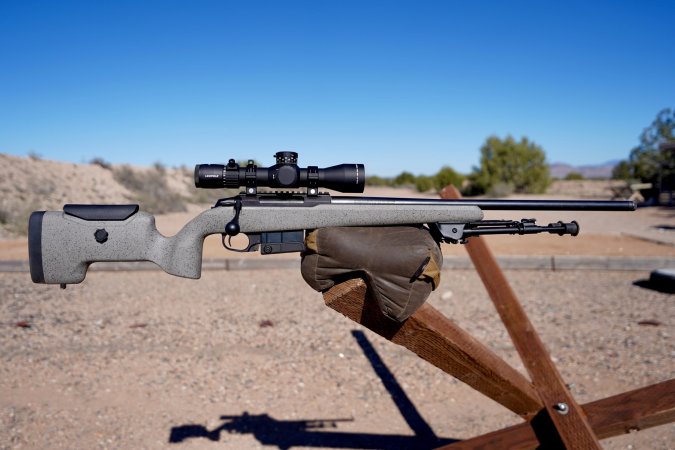
See It
- Test Gun: 6.5 CM
- Average Group: .633 inches
- Best Group: .493 inches
The NRL Hunter series was created to give hunters a chance to put their skills and equipment to the test. Shooters start from a blind position and must find, range, and engage targets on the clock using gear that is suitable for big game and doesn’t exceed specified weight limits. In the case of the “factory” and “light” divisions, that figure is 12 pounds and includes the rifle, optic, bipod, and other accessories one might mount to the gun.

The Tikka T3x UPR is one rifle that’s used widely—and with great success—in the factory division. Its accuracy and handling match well with the fast-paced stages one encounters in the series, where the targets typically range from 200 to 800 yards away.
I recently reviewed the Tikka T3x UPR, breaking down the features that make it such a good rifle—especially for the price.
In short, the rifle has an excellent stock that is designed to be steady in field positions. It’s shape works with you whether you’re shooting prone or bracing it on something like a rock, cattle gate, or tree branch. The adjustable trigger is terrific. And the rifle, like others in the Sako/Tikka line, has intuitive controls, feeds and cycles ammo reliably, and is accurate.
The fact that it is good for NRL Hunter also makes it a smart choice for hunting and casual long-range shooting.
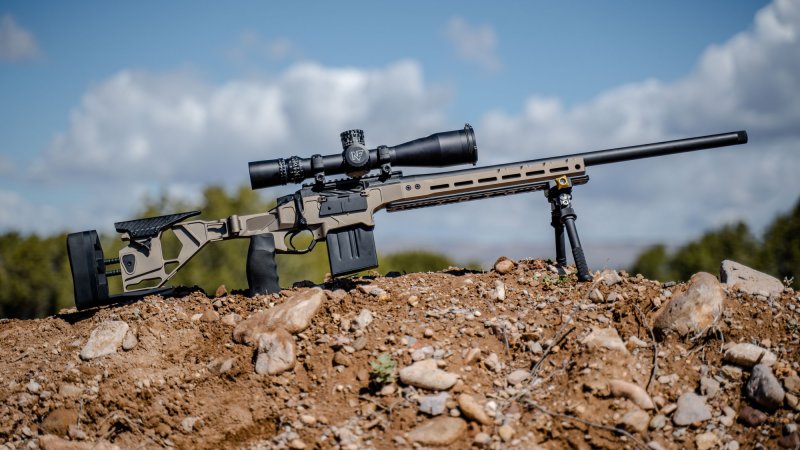
The Seekins Havak HIT is one of the best values in the precision rifle world.
See It
- Test Gun: 6.5 PRC
- Average Group: .524 inches
- Best Group: .482 inches
This rifle caught our attention in a way that few firearms have in recent years. In the initial writeup I mentioned that my fellow gun testers and I were blown away by how well this original, innovative, versatile, and accurate rifle performed.
Chambered in 6.5 PRC and weighing a reasonable 13 pounds, it coughed up legit 1/2-MOA performance with factory ammunition.

Glen Seekins designed a relatively svelte folding chassis stock for the Havak HIT that functions great, but doesn’t tack on unnecessary extras. By loosening one set-screw a person can quickly swap barrels on the rifle, and changing out the bolt head to switch from one class of cartridges to another is nearly as simple.
This means the HIT can be used for general plinking, can be run in long-range field matches with weight restrictions and, with a carbon-fiber barrel installed, would be a portable (and accurate) hunting rifle.
If we were to anoint one rifle as the do-it-all champ, the Seekins Havak HIT would claim the belt.
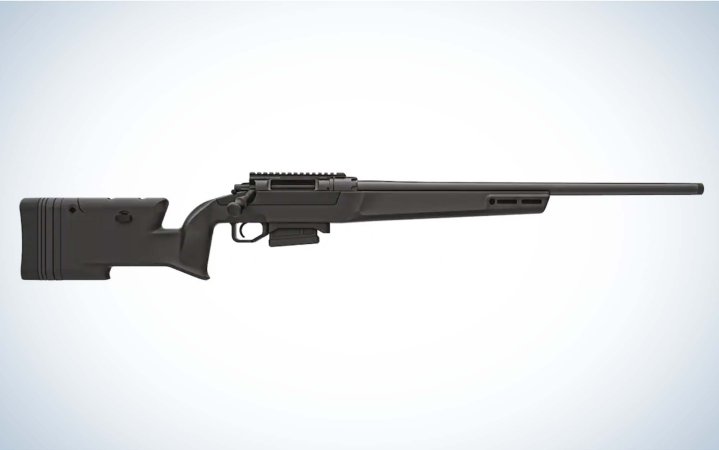
See It
- Test Gun: .308 Winchester
- Average Group: .639 inches
- Best Group: .346 inches
This accurate, no-nonsense rifle is built around an excellent three-lug action that operates nearly effortlessly and is mated to a stock with impressive ergonomics and adjustability. Daniel Defense introduced the Delta 5 in 2019 and due to the quality of the rifle and its competitive sub-$2,000 price, it has managed to gain a foothold in the competitive high-end bolt-action market.
The company didn’t skimp on features. The ambidextrous grip is among the best I’ve seen, and the cheek piece can be tweaked in every dimension—height, lateral position, and yaw. It has a 20-MOA scope rail. The butt stock adjusts for length of pull. The stock incorporates QD sling attachment points. The Timney trigger adjusts from 1.5 to 4 pounds.
The one I tested really like Federal 168-grain Sierra Matchkings, turning in multiple groups that averaged ½-MOA. That’s fantastic performance, especially for a .308 shooting factory ammo.
Why Long-Range Rifles Are Getting More Accurate
Victory has a thousand fathers, the saying goes. There’s truth to that as it relates to precision shooting. One needs only to look at the components of a rifle that contribute to accuracy—barrel, action, stock, trigger, brass, propellant, projectile, optic—and it is clear that the long-range performance we currently enjoy traces its origin to many sources. Without getting too deep into the weeds on any of these elements, we can identify some common themes.
Tighter Manufacturing Tolerances
One is the state of manufacturing capabilities with gun, ammo, and optics companies. The prevalence of CNC machining allowing for tight tolerances has given rise to components that a hobbyist at their workbench can literally screw together to build an accurate rifle. This plug-and-play interchangeability speaks to a level of consistency we’ve never had before. And, as long-range shooters know, consistency is key to accuracy.Take bullets, for instance. Whereas serious shooters would often sort bullets by weight to cull those that deviated too much from the average, we now have projectiles by Lapua, Berger, and Hornady that are dead-nuts consistent from one to the next. The Hornady A-Tip is a great example of this. The same holds true for the makers of premium brass like Alpha Munitions, Lapua, Peterson Cartridge, and ADG.
Rapid Evolution of Gear
All systems in life evolve or eventually perish. But the rate of evolution isn’t a constant. Looking at the history of long-range shooting from the late 1800s until today we can identify many milestones that changed the game. The development of telescopic rifle sights. The adoption of smokeless powders. The introduction of composite stocks and pillar bedding.
The early 1900s was one era of rapid change and evolution in the accuracy game. The mid 1950s, with the introduction of many long-range magnum cartridges was another. But I’d argue those pale in comparison to the evolution in our gear over the last 20 years.
We now know how to make better long-range rifle cartridges, thanks to the principles of Modern Cartridge Design, than ever before. Our ability to calculate trajectory solutions for elevation and windage with products such as Hornady’s 4DOF solvers and Applied Ballistics software found in devices such as Kestrel ballistic meters and laser rangefinding binoculars (like the Leica 10×32 Geovid Pro) has changed the game. Even something seemingly as basic as rifle bipods have evolved in recent years to help us become better long-range marksmen under practical field conditions.
Rapid Evolution of Shooting Skills
The evolution of our marksmanship skills goes hand-in-hand with the evolution of our gear. One compliments and encourages the other. This dynamic interplay is, in fact, inseparable.
We see this on the military side of the equation because of the outsized role that snipers played in the wars in Afghanistan and Iraq, and in the civilian world where the explosive growth in the popularity of long-range steel matches created a Darwinian laboratory where new ideas were tried and fine-tuned or rejected at a dizzying clip.
For instance, sandbags—which just used to be something to rest your rifle on when sighting in—have become an essential piece of gear for long-range shooters who employ a bevy of techniques to get the most out of them.
FAQs
For fear of being snarky—yes, absolutely long-range rifles are worth it. I say that because rifles that qualify for the category—meaning those capable of consistently shooting .7 to .8 inch five-shot groups or better have become more common and more affordable.
You can drop $10,000 on an Accuracy International AXSR and I doubt you’d feel short changed once you shot it. But if that’s out of your budget, something like the Mossberg Patriot Tactical LR or the Mauser M18 can serve you well for long-range shooting for less than $1,000.
Long-range rifles serve numerous roles. They are sniper rifles for the military and law enforcement agencies. They are used in a wide variety of competitions. And, they are effective for hunting at extended distances. And they are commonly used for recreational shooting at distant and/or small targets.
This is a common question asked about long-range rifles. As with most complicated questions the answer is—it depends.
When shooting steel in a match, some bullets and cartridges are capable of accurate fire beyond 2,000 yards. A good example is the .300 PRC shooting Hornady’s 230-grain A-Tip.
In a military role, that’s about the effective range of the ammo as well, even though there are some recorded shots at significantly longer distances. Those are the exception, however, rather than the rule.
For hunting, the max effective distance of a long-range cartridge is much closer. The reason is that the rifle and ammo must be accurate enough to make vital zone hits every time, and the bullet must have enough retained velocity to quickly and ethically kill the animal.
This is to say nothing of the shooter’s skill and judgment, which must be exceptional as well.
As a rule of thumb, any shot on a game animal farther than 650 yards becomes a very dicey affair—and even that is a poke that should only be considered under rare circumstances.
Any long-range rifle that is easy to carry and maneuverable in the field would make for a fine deer rifle. While the level of precision found in long-range rifles isn’t necessary for deer hunting at most distances, having a rifle capable of pin-point accuracy is never a bad thing.
The key to using a long-range rifle for small game hunting is choosing a bullet and cartridge combination that is suitable for the game. You don’t want to go overboard and use a round that will obliterate good meat, so be sure to pick a milder cartridge with a bullet that won’t violently fragment on impact. A .17 HMR is a good choice, as is an accurate .22 LR.
Read Next: The M1 Garand, the Greatest Generation’s Service Rifle
Final Thoughts On Long-Range Rifles
Today’s long-range rifles have become so good that I don’t think we’ll see major improvements in their accuracy anytime soon. That’s not to say the quest for one-hole groups is over. It’s just that future gains will be incremental.
The rifles that today shoot a quantity of five-shot groups that average .5 or .6 inches, might someday become legitimate .4-MOA rifles with some that inch down into the .3s. But I doubt any of them will achieve that mythical quarter-MOA status that so many Facebook snipers boast about.’
That said, you can accomplish amazing things with a rifle that shoots between ½- and ¾-inch. With a good wind call and a ballistic calculator, ringing steel at 1,000 yards is child’s play. Engaging targets at one mile (assuming you’re using a good target bullet) is quite doable. And excuses for missing a deer at any reasonable distance fly out the window.
These are the best of times for the rifleman. I hope you’re taking advantage of it.
Read the full article here

